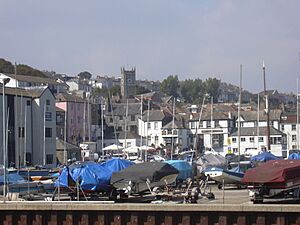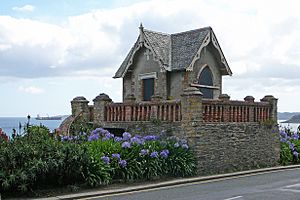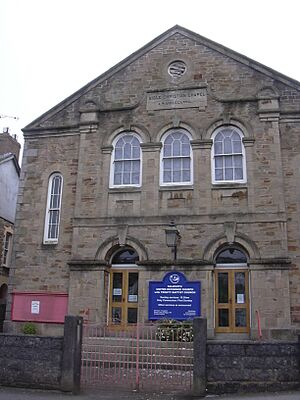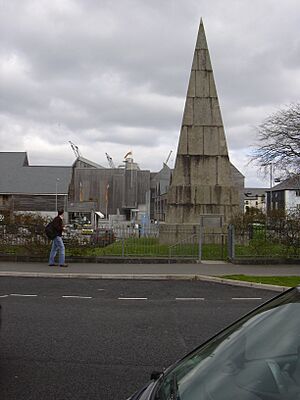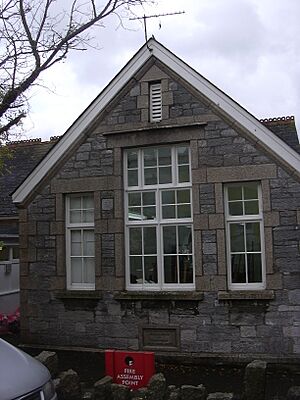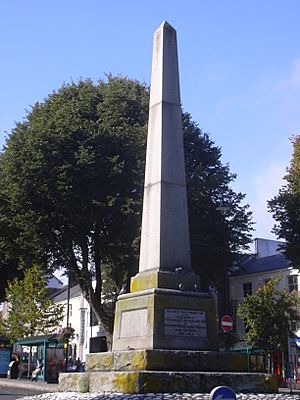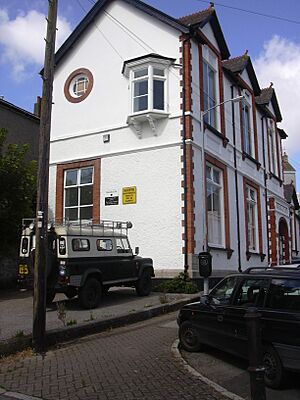Miss Susan Gay's Falmouth chronology facts for kids
This article shares a timeline, also known as a chronology, of the town of Falmouth in Cornwall, England. It's based on information from a book called Old Falmouth by Miss Susan E. Gay, published in 1903. A chronology helps us understand the order of important events that shaped Falmouth over many years.
Contents
Falmouth's Early Days: Before the 1700s
- 9th century: It's believed that Pendennis Point was fortified by the Danes.
- 1120: The area now known as Gyllyngvase got its name.
- 1403: The Killigrew family took ownership of the Arwenack estate.
- 1538: An old fort was built on Pendennis Point. This was the start of the strong defenses there.
- 1542: St. Mawes Castle was built across the water from Falmouth.
- 1542–1544: Pendennis Castle was constructed during the time of King Henry VIII. Sir John Killigrew became its first Governor.
- 1567: The Arwenack manor house was built by John Killigrew.
- 1600: A small pub called "Penny-come-quick" opened near Greenbank quay.
- 1613: Falmouth began to grow significantly, thanks to a plan by Sir John Killigrew.
- 1613: Nearby towns like Truro, Penryn, and Helston complained to King James I about Falmouth's rapid growth.
- 1619: Sir John Killigrew set up a lighthouse at The Lizard to help ships.
- 1642: Prince Charles (who later became King Charles II) found safety at Pendennis Castle during the English Civil War.
- 1644: Queen Henrietta Maria stayed at Pendennis Castle on her way to France.
- 1646: Pendennis Castle was surrounded and attacked by Cromwell's forces. Arwenack House was partly burned. The castle surrendered in August 1646.
- 1650: The Custom-house, where taxes on goods were collected, moved from Penryn to Falmouth.
- 1652: Markets were officially started in Falmouth by Sir Peter Killigrew.
- 1655: George Fox, who founded the Quakers, visited Falmouth.
- 1660: King Charles II officially changed the names of Smithike and Penny-come-quick to Falmouth.
- 1661: Falmouth was granted a special charter by King Charles II, allowing it to become an official town.
- 1662: The Parish Church was built. It opened in 1663 and was officially blessed in 1664.
- 1664: Falmouth Parish became separate from the nearby parishes of Budock and Gluvias.
- 1664: There were about 200 houses in Falmouth.
- 1688: Falmouth became a Packet station. This meant ships carrying mail and passengers regularly sailed from Falmouth to other countries.
- Close of 17th century: Falmouth had grown to about 350 houses.
Falmouth in the 1700s
- 1703: A gallery was added to the south side of the Parish Church, and an organ was placed at the west end.
- 1705: Five packet ships were sailing regularly between Falmouth and the West Indies.
- 1709: Falmouth's leaders successfully claimed control over Falmouth harbour, winning a dispute with Truro.
- 1715: A Congregational Chapel was built.
- 1717: Pendennis Castle was hit by lightning and badly damaged.
- 1725: A Town Hall was given to Falmouth by Mr. M. L. Killigrew.
- 1745: John Wesley, a famous religious leader, visited Falmouth.
- 1748: Fairs were held in Falmouth in July and October.
- 1750: A Seamen's Hospital was established to care for sailors.
- 1750: Falmouth had grown to between 500 and 600 houses.
- 1754: The Methodist movement began in Falmouth, also started by John Wesley.
- 1757: Benjamin Franklin, a famous American, landed in Falmouth on his way to America.
- 1766: The first Jewish Synagogue was built.
- 1781: The Falmouth Bank was established.
- 1785: A new Custom House was built near Arwenack.
- 1788: A large fire caused significant damage in Church Street.
- 1789: Grove Hill House, an important building, was started.
- 1791: A Methodist Chapel was built in Killigrew Street.
- 1792: Another major fire destroyed 42 houses and the local theatre.
- 1792: Sunday Schools were founded in Falmouth, providing education for children.
- 1795: New batteries (defensive structures) called Crab Quay and Half Moon were built below the Castle.
- 1798: An organ was placed in the gallery of the Parish Church.
- 1800: The Church tower was made taller to hold a clock.
Falmouth in the 1800s
Early 1800s: 1801–1810
- 1801: Falmouth's population was 4,849. Between 1801 and 1811, 719 new houses were built.
- 1802: A charity school for girls was founded, followed by one for boys in 1804.
- 1803: A Roman Catholic Mission was founded.
- 1807: A Public Dispensary (a place for medical care) was opened.
- 1808: A large military expedition of over 12,000 soldiers sailed from Falmouth.
- 1809: The pilots who guided ships into the harbour were regulated by the Trinity Board.
- 1810: A Charitable Society was founded to help those in need.
- 1810: There was a mutiny among the packet-men (sailors on the mail ships).
Growing Pains: 1811–1820
- 1811: Free schools for girls and boys were organized by Miss Howell.
- 1812: The Parish Church was made longer at the east end.
- 1812: An accident at the Parish Church caused several deaths.
- 1814: Peace was proclaimed, and there were big celebrations in Falmouth.
- 1814: The Queen transport ship was wrecked, and 195 people drowned.
- 1815: Between 30 and 40 packet ships were sailing to and from Falmouth.
- 1815: Napoleon Bonaparte, the famous French leader, was brought into Falmouth Harbour on board HMS Northumberland.
- 1817: The Falmouth Savings Bank was founded.
- 1819: The first Gas-Works were established, bringing gas lighting to the town.
- 1820: A new Roman Catholic Chapel was built on Green Bank.
Expansion and Change: 1821–1830
- 1821: Falmouth had 850 houses and a population of 7,000.
- 1824: A Classical and Mathematical School was built.
- 1825: The ship Kent caught fire in the Bay of Biscay, but 547 people were rescued and brought to Falmouth.
- 1826: Public Reading and News Rooms were opened.
- 1827: A National School was opened on Mount Sion.
- 1827: Falmouth had grown to 900 houses and over 8,000 inhabitants.
- 1828: Donna Maria da Gloria, who would become Queen of Portugal, landed at Falmouth.
- 1829: The Falmouth Packet and Cornish Herald newspaper started.
New Beginnings: 1831–1840
- 1831: The ex-Emperor and Empress of Brazil visited Falmouth.
- 1832: Falmouth and Penryn were joined to form a single area for electing Members of Parliament.
- 1833: The Royal Cornwall Polytechnic Society was founded, along with a Public Library.
- 1833: Falmouth experienced an outbreak of Cholera.
- 1834: The Polytechnic Hall was built.
- 1834: St. Anthony's lighthouse began construction.
- 1835: The office of Lieut.-Governor of Pendennis Castle was removed.
- 1837: Around 40 packet ships were sailing to and from Falmouth.
- 1840: Gyllyngdune House was built by the Coope family.
Mid-Century Milestones: 1841–1850
- 1842: The Governorship of St. Mawes Castle was abolished.
- 1843: Queen Victoria and Prince Albert visited Falmouth on September 1st.
- 1846: Queen Victoria and Prince Albert made a second visit to Falmouth.
- 1847-1848: Falmouth Water-works were established, providing water to the town.
- 1848: The Atheneum Library and Museum were founded.
- 1849: The British and Foreign Sailors' Society was founded to help seamen.
- 1850: Falmouth stopped being a Packet Station, as mail services changed.
Modernizing Falmouth: 1851–1860
- 1851: A Union Workhouse was founded.
- 1852: The Royal Cornwall Sailors' Home was founded.
- 1857: The Falmouth Cemetery was laid out.
- 1857: An Electric Telegraph Company station opened, bringing faster communication.
- 1858: H.M.S. Russell, a training ship, was stationed at Falmouth.
- 1859: The Cornwall Railway opened to Truro, connecting Falmouth by rail.
- 1860: The Docks began construction, a major development for the port.
- 1860: Greenwich Time was generally adopted in Falmouth.
Growth and Development: 1861–1870
- 1861: The Parish Church received three new bells.
- 1861: Missions to Seamen began, providing support for sailors.
- 1862: A major fire in High Street destroyed 30 houses.
- 1863: The Railway officially opened to Falmouth, leading to big celebrations. A very large whale was also towed into the harbour!
- 1864: A new Town Hall began construction.
- 1864: General Giuseppe Garibaldi, a famous Italian leader, visited Falmouth.
- 1865: The Falmouth Hotel opened.
- 1865: A drive was made around Pendennis Castle, making it easier to visit.
- 1866: A Chamber of Commerce was founded to support local businesses.
- 1866: New Gas Works opened.
- 1867: The Falmouth Observatory was established to study weather and climate.
- 1867: A Life-boat was established, ready to help ships in distress.
- 1867: Three ships were wrecked at Gyllyngvase.
- 1869: The Roman Catholic Church was built in Killigrew Street.
- 1869: Earle's Retreat was built to provide housing for aged persons.
- 1870: Another large fire occurred at Market Street.
- 1870: A Harbour Board was formed to manage the port.
Late 1800s: 1871–1880
- 1871: New landing places were built at Fish Strand and Market Strand.
- 1871: The Killigrew Obelisk, a monument, was moved to the green in front of Arwenack.
- 1872: The Royal Cornwall Yacht Club opened.
- 1873: A Direct Spanish Telegraph connection was established, improving international communication.
- 1873: A Volunteer Drill hall was built.
- 1874: H.M.S. Ganges, another training ship, arrived in Falmouth.
- 1875: A School Board was formed to oversee education.
- 1877: Kimberley Park was given to the town by the Earl of Kimberley.
The Final Decades: 1881–1890
- 1881: A Climatological Station was established at the Observatory to collect weather data.
- 1882: The Jubilee Exhibition of the Polytechnic Society was held.
- 1883: A Cottage Hospital and Nursing Home was founded.
- 1884: The foundation stone for a second Meteorological Observatory was laid.
- 1885: Falmouth lost one of its Members of Parliament due to changes in voting areas.
- 1887: A High School for Girls was built.
- 1887: A Recreation Ground was opened for public use.
- 1887: Queen Victoria's Golden Jubilee (50 years on the throne) was celebrated with bonfires.
- 1887: The Prince of Wales visited Falmouth and laid the foundation stone for All Saints' Church.
- 1889: All Saints' Church was officially blessed.
Turn of the Century: 1891–1900
- 1891: A severe Snow Blizzard hit Cornwall, causing trains to get stuck.
- 1891: The Census showed Falmouth had 2,400 houses and over 10,000 inhabitants.
- 1892: The railway track gauge (width) was changed from broad to narrow on the G.W.R. in just 50 hours.
- 1892: The Borough of Falmouth was expanded and strengthened.
- 1892: A large sum of money was left by Mr. Octavius Ferris to create a Free Library.
- 1893: The foundation stone of Falmouth Hospital was laid.
- 1893: The Pendennis Hotel opened.
- 1894: The Municipal Building and Free Library were built by Passmore Edwards.
- 1894: The Falmouth Sailing Club was founded.
- 1894: An Art Gallery was built.
- 1897: A Board School for boys was built at Wellington Terrace.
- 1897: Queen Victoria's Diamond Jubilee (60 years on the throne) was celebrated.
- 1897: A Time-ball was installed at Pendennis Castle, used to signal the exact time to ships.
- 1898: The restoration of the Parish Church was completed.
- 1898: The Packet Memorial was put up in the Moor, remembering Falmouth's history as a packet station.
- 1898: The SS Mohegan was wrecked on The Manacles, with the loss of 106 lives.
- 1899: The training ship H.M.S. Ganges left Falmouth.
Falmouth in the 1900s
- 1901: King Edward VII was proclaimed king.
- 1901: The Art School began in Manor Avenue.
- 1901: A new Police Station was built in the Moor.
- 1901: The Census showed Falmouth's population was 11,173.
- 1901: The Old King's Arms Inn at Market Strand was pulled down.

All content from Kiddle encyclopedia articles (including the article images and facts) can be freely used under Attribution-ShareAlike license, unless stated otherwise. Cite this article:
Miss Susan Gay's Falmouth chronology Facts for Kids. Kiddle Encyclopedia.

